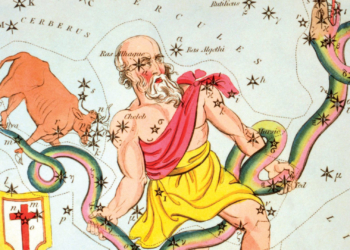
By Kingsley L. Dennis | kingsleydennis.com
‘The attraction of the void is irresistible.’ ~ Jean Baudrillard
If you feel like you are unsure of what is real and what is unreal then you are not alone. Our materialistic mode of life is accelerating and expanding so rapidly that it is saturating our modern cultures to the point of abstraction. Life in materially-privileged societies is increasingly shifting into a world of image and show. Many people today are living within their bubbles that are customized by all the digital conveniences tailored to individual needs. By being surrounded by conveniences that satisfy all our needs we are deliberately excluding so much else, including all of life’s serendipities.
Reality – whatever that is or was – has retreated behind a spectacle of make-believe that is playing at being the new, shimmering façade for the 21st century. One result of this is that things which once stood in opposition to one another are losing their meaning and becoming indistinguishable. That is, fixed identities that used to make life easy for us – us/them, friend/enemy, good/bad, and the rest – are now more like false realities. Life has shifted or has been pushed, into a realm of the invention that is being exploited ever more overtly by politicians, mainstream media, and their propaganda machinery. Out of this, a different sense of reality has emerged that succeeds in absorbing differences and contradictions and making them seem smooth rather than jagged. And the result is what I refer to as hyperreality.
The hyperreality pill
It is no longer the jagged pill we are forced to swallow, but the smooth pill we are willing to pop. And this smoothness is presented as succulent and easy to swallow. Our modern cultures want us to think that they are simple, smooth, and therefore require our willing obedience. As a consequence, many of us no longer know or care in knowing, where the resistance is. And if we do feel the need to express resistance, we find ourselves at a loss of where it should be placed. The ‘smooth ideal’ is that society is managed so there can be no efficient resistance against it. This is what Herbert Marcuse once referred to as a ‘comfortable, smooth, reasonable, democratic unfreedom.’ The hyperreal evades any real contact. It is like being at the end of a phone call when waiting for the automated voice service. This evasive strategy of the hyperreal has succeeded in obscuring any site of resistance. It’s all so ‘real,’ and yet, of course, it is not.
The original notion of hyperreality (a term borrowed from semiotics and postmodern theory) is an inability of consciousness to distinguish reality from a simulation of reality, especially in technologically advanced societies. We are no longer faced with the threat of struggling with our shadows – we are now faced with the threat of our clones. This may be the radical illusion we are slipping into.
Yet the radical illusion of the world has been faced by all cultures. It has been described by mystics, symbolized by art, and struggled over by philosophers. The notion of illusion is not the main issue – rather, it is the medium through which it is conveyed. Or, more importantly, whether it is deliberately exaggerated and amplified. And how by who – and why? An illusion is now perhaps our greatest industry, especially in western societies. Illusion is the consensus story we are told when growing up and which we all believe in. It’s the story that’s always been told because ‘that’s the way it’s always been.’ No wonder there is so much confusion, which is then fed by another great western industry – therapy.
Hyperreality plays a somewhat different game, with new rules and a different deck of cards. The paradox today is that those of us caught up in the game have no idea what the gameplay is. This is similar to a Jorge Luis Borges short story ‘The Lottery in Babylon’ where all activities in life are governed by the lottery; that is, by chance. And the lottery is run by ‘The Company,’ the rules of which not only are the rules of the game but become the rules of life. If that’s not confusing enough, then we need another hyperreality pill.
Please sir, can I have some more hyperreality?
Hyperreality – the inability to distinguish the real from simulation – has become our new reality structure (perception set) and is constructed so that everyone believes in it and goes along with it. There is an underlying feeling that something is not quite right, yet our sense of reality often appears so extreme that it becomes ‘extra-plausible.’ It appears that strange walls of falsehood are being erected between the individual and what is real. The result is a distortion of how we see things. In other words, a perception distortion. To put it simply, hyperreality can be described as the normalization of delusion. When mass society adheres to a collective delusion we call it normal or ‘reality,’ and if one person strays too far from this consensus thinking then we often label them as delusional, or unstable. It is as if we have been struck by on-coming car headlights and we are like dazed rabbits in the middle of the road. Better not sit around too long wagging our fluffy tails!
The hyperreal smoothes and soothes all contradictions. When once we thought we had ‘left’ politics and ‘right’ politics, these distinctions are now nullified. There is no more any ‘left’ or ‘right,’ only agendas that use varying means to acquire the same power. Any basis of truth has slipped into the sleek substitution – the simulation. Let me ask a question: Do we really think that the face of politics, for example, represents any vestige of truth? There is no more truth in politics than there is in someone wearing a laboratory coat in a television commercial trying to persuade us to buy a particular brand of detergent. There are persuasion and falsity that parades as an element of truth, yet it is a pure simulation. We have slipped into an age where the new ‘reality principle’ tells us that nothing is out of reach and that almost everything can be bought for a price. That is, the real is solid and exists as the flow of goods, services, desires, wants, pleasures, and almost instant availability.
The question now is how far can the world go before yielding to a permanent state of hyperreality? Perhaps we are already in this state right now; after all, the hyperreal is contagious, like a chain reaction. In the hyperreal world, the space of communications is condensed into the simultaneous now; marginal spaces on the periphery are now the hidden spaces where secrecy flows in offshore networks. Our networks of mobility and movement are fragmented into those that privilege some and exclude the many. Even the space above our heads is colonized by the satellites that spy on us. We have street views being watched and analyzed by Google. Our movement, speech, and text being spied on processed and interpreted by intelligent algorithms. We have injected a ‘smart-virus’ into the Earth in order to monitor all activity.
Our smooth digital flows allow – with precision and efficiency – for many aspects of our national and private economies to be shifted to the periphery where the secret networks operate. Only the hyperreal economies remain in the spotlight. There is now a global offshore world that moves in exclusive, mostly secretive networks. The phenomenon of offshoring has transformed peripheral and marginal places into central nodes. Offshored economies had mostly operated in the unseen shadows until the scandal of the Panama Papers in 2015. This massive leaking of documents led to political and celebrity scandals across the world, forcing many politicians to resign from their coveted positions. Presidents are now further pressed to release their tax returns to prove their legitimacy. Yet with the farce within the hyperreal, such players as US President Donald Trump can evade these processes with blatant deceptions. Offshored secrecy and surveillance are central to the functioning of contemporary societies.
Hyperreality is also about the disappearance.
Please sir, can you tell me where I can find some hyperreality?
Hyperreality is not only about speed and velocity; it is also about size – things are condensing into ever-smaller spaces before disappearing altogether. Our urban habitats, information flows, financial transactions, have all shown increased density at the same time as velocity. Financial crashes today are more explosive because they affect so many more systems on a global level. They are dense in their complexity.
At the core of the condensed form what we once knew as the real begins to disappear. At the extremity of economics, the value of money disappears. At the extremity of warfare, there is no real humanity, only insanity, and immense sorrow, loss, and pain. At the extremity of sexuality, there is no warmth only the pornography of lust and the commodity of desire. At the extremity of goodness, there is the greed to do good. And even at the extremity of love, there is no real love, but obsession and possession. Within these extremities, we lose touch with anything that once came close to the real. We are in the slipstream of the hyperreal where the substitute replaces its former host. And the substitute is ‘always-on’ 24/7.
An ‘always-on’ hyperreal world also creates the illusion of mobility. Precisely because we can be connected throughout the world by the technologies in our pocket we are no longer required to move. We can be in the office while speaking with colleagues across the globe or chatting with friends on another continent whilst remaining seated on our sofas. The contradiction here is that hypermobility creates its own sedentary life. This was explored in the sci-fi film Surrogates (2009) where people purchase remote-controlled humanoid robots to conduct their social life and affairs whilst the real person remains at home wired to their chair. Of course, everyone chooses a pretty or handsome humanoid to represent them (just like avatars in the online world) whilst their real bodies lie fat and underused in the unmoving chair.
We have yet little cultural experience to protect us from the invasion of simulation, artificiality, and the hyperreal. It has all happened too quickly for us and our senses have not fully adjusted. Some of us are struggling with aching bodies, restless sleep cycles, and tired eyes from all the screens in our lives. It is not motion sickness we are suffering from more and more but monitor sickness. One of the features of hyperreality is that communication occurs extremely rapidly, and we are bombarded with information almost constantly.
The hyperreal brings to the fore a convincing collection of disastrous non-events. Everything that is happening somehow gets reported, transmitted, and commented upon, creating an explosive babble of micro-impacts that dominate our superficial conversations. Then the next day they have disappeared into a black hole of amnesia and replaced by another twenty-four-hour dose of attention-topics. This hyperreal lifestyle creates a background noise; a seemingly endless low static buzz that infests our everyday spaces. It’s like the static we experience when changing radio channels, or when a digital television channel isn’t yet synchronized.
Many of us are living in a high-velocity, always-connected, post-historic world. For those people who are not yet attuned to this it is highly unpleasant. Things seemingly take place, but we are not quite sure. This is the dilemma. The hyperreal takes the wounded soul and Photoshops it into a caricature of its former self. It becomes glorified and falsely beautified into the less real, but with hyper-appeal. Events and issues are glossed over, making truths little more than quick sound-bites that flash before our eyes. Despite these absurdities we are still living in a world that is physically very real.
The hyperreal in overreaction and overload
We ultra-react because we are continually under bombardment by a stream of information that keeps us in overload. We wish to know as much as possible about what is going on in our environment because this used to be an evolutionary survival strategy for our ancestors. Yet our distant ancestors didn’t have the Internet, smartphones, and a whole array of connected gadgets – they had clubs and hatchets. We’ve changed our rhythms, or rather our new technologically-pervasive environment has altered our rhythms, and we’ve not had sufficient time biologically, as well as psychologically, to adjust.
We are waking up to a world in a new rhythm, with a new, faster speed and an altered resonance; and frankly for most of us it makes us feel as if we’re partially inebriated. The world is making our children respond to its hyperreal energy, and then subsequently we go about tranquilizing them. The rise of young schoolchildren in the modern world taking medications for ADHD (attention deficit hyperactivity disorder) is phenomenal. In such a world it becomes much harder to practice and maintain certain types of attention, such as contemplative, reflective, and introspective thought. We are accessing information, yet less so are we translating this information into rich, interior states or memories.
It is as if we are afraid to be bored. We may feel that being bored – or being boring – is a failure; that we have failed to make use of all the information and opportunities at our fingertips. Yet the brain is continually working hard to process all information and external impacts, and so we need to take time off to relax, recharge, and replenish. We need to retain our attentiveness instead of giving in to the lazy approach of digitally-offloading our attention. We cannot navigate our own path through life by GPS. At the same time, retaining attention should not require artificial, chemical inducers. Nor should it require copious amounts of fantasy masquerading as the real.
Many highly developed cultures are already basking in the ‘Disneyfication’ effect where western commercial pursuits, practices, and values are promoted around the world as a panacea for all. Disneyfication gives us bigger, faster, and better entertainment that’s the same the world over – US mass culture values on the global stage. Disneyfication hides the ‘real’ places, yet paradoxically many people seem to prefer being in the imaginary. Perhaps its real function is to make us believe that the rest of society is imaginary and only that which resides within the walls of Disney is real. In the hyperreal the spectacle becomes the lived space of our social lives. Disney is colonizing our lives and that colonization becomes the new world map.
The Argentinian writer Jorge Luis Borges famously wrote of a great Empire that created a map that was so detailed it was as large as the Empire itself. The actual map grew and decayed as the Empire itself conquered or lost territory. When the Empire finally crumbled, all that remained was the map. This ‘imaginary map’ finally became the only remaining reality of the great Empire: a simulation of the once physical reality that has now been colonized by its own spectacle. This is where the Real loses its center and becomes origin-less.
The hyperreal too evades a sense of origin, which accounts for the rise in nostalgia, retro-revival, and people dressing up as superheroes. Star trek conventions, speaking Klingon, and entering a whole new universe meshes with the online worlds and their avatars. In the realm of the hyperreal the origin is origin-less, and real place is place-less. We are given new maps of celebration and celebrity that hide a commodity fetishism – yet where is the meaning? We crave for meaning.
The hyperreal incorporates everything within itself. There is no outer or inner within its realm. The only escape is a form of transcendence – a process or act of gnosis – that can see through the superficiality of the spectacle. This is the current dilemma – our systems are extending but not transcending themselves. Many of us are in this situation: we go for more of the same, only a little bit different. The answer lies in becoming beyond difference. Life has always been a sequence of events that we ascribe meaning too.
When we experience this sequence in a reasonable enough form then we create our meanings. It is when this sequence of events and signs becomes asymmetrical, non-linear, or accelerated beyond our limits of standardized perception that we begin to lose our ability to ascribe significance to it. Hyperreality is the zone where this slippage occurs and meaning loses its anchorage. The result is that we feel we are being carried away from ourselves. We are being pulled into the flux and flow of this hyperreality and we lose sight of the ground. Not only the grounded-ness of place, but also our inner ground – that part of us which makes us feel human. It is the soulful part of us that we are losing.
In these hyperreal times we need to find a new balance and arrangement between things. Our old arrangements are shifting, and those things once in perceived stability and order are losing their moorings. We should remember that the ‘Real’ exists somewhere inside of us and keep this in mind as the world outside continues its head-long rush into a frenetic, whirlwind of chaotic events. In the end, we can only truly rely on our own good sense and intuition. As Václev Havel stated in one of his addresses, ‘Transcendence is the only real alternative to extinction.’
We must try to remain stable and as sane as possible as life accelerates into its own hyperreality. Otherwise we may not find our own center within the global maelstrom. The ride has only just begun.
About the Author
Kingsley L. Dennis is the author of The Phoenix Generation: A New Era of Connection, Compassion, and Consciousness, and The Sacred Revival: Magic, Mind & Meaning in a Technological Age, available at Amazon. Visit him on the web at https://www.kingsleydennis.com/.
References:
[1] Yates, Francis. The Rosicrucian Enlightenment. London: Routledge, 2001.
[2] Quoted in Noble, David F. The Religion of Technology: The Divinity of Man and the Spirit of Invention. London: Penguin, 1999, 134.
[3] Davis, Erik. Techgnosis: Myth, Magic and Mysticism in the Age of Information. New York: Three Rivers Press, 1998, 9.















